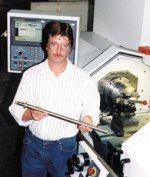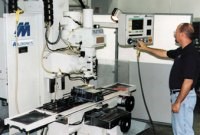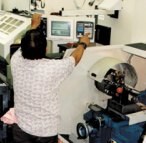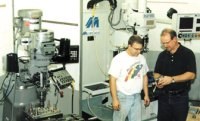Machines For Today's Toolrooms
If there's room for improvement in any NC program, this shop addresses the problem once and for all by making the correction in the postprocessor.
Until recently, toolrooms have resisted the trend to CNC machine tools. Now, however, a growing number of toolrooms are replacing their worn-out manual milling machines and lathes with so-called combination machines—machines that can be operated manually but also under computer control, like their counterparts on the production floor. Here's a look at several toolrooms that have made the transition and some of the reasons for the switches.
ITT Bell & Gossett (Morton Grove, Illinois) manufactures a large variety of centrifugal pumps and related products for residential and non-residential hot water heating and cooling, industrial process, general service and pressure-boosting applications. Production operations include machining of the (mostly) cast iron pump bodies and brackets, fabrication of steel components such as motor jackets, motor and pump assembly, and testing.
The firm's manufacturing operations are supported by a large toolroom that, until recently, was equipped exclusively with manual machine tools: Bridgeport knee-and-column mills, some lathes and some grinders. The toolroom's work load consists primarily of repairing or replacing die components, making machining and assembly fixtures, and replacing worn or damaged parts of production machines.
"Three years ago, we needed to replace some worn mills and lathes," recalls Joseph D. Kowalczyk, toolroom supervisor at the Morton Grove plant. "We didn't want to simply buy newer versions of the old machines; we wanted more efficient machines capable of producing more accurate parts in less time.
"At the time, we had a machining center in the toolroom, but only two people in the department knew how to operate it," Mr. Kowalczyk continues. "When they weren't around, the machine sat idle. Our company had already made the transition to CNC machine tools out in the factory, so we were aware of their advantages. However, our toolroom people didn't know the first thing about programming and operating a CNC machine. If we were going to benefit from CNC technology in the toolroom, we needed a machine that was easy to learn and easy to operate."
Mr. Kowalczyk found what he was looking for in the EZPATH SD lathe and the EZTRAK Series I milling machine, both made by Bridgeport Machines, Inc. (Bridgeport, Connecticut). Both machines have electronic handwheels and can be operated like any other manual machine in the shop. However, each also has a two-axis CNC control that allows the operator to generate a machining program by selecting numerous "canned" machining cycles offered from the control's menu and providing dimensional data as prompted. After the operator prepares the program, he or she can check its correctness by viewing a graphic of the machining sequence on the control monitor. The CNC control incorporates a "teach" mode that keeps track of the machining steps as they are developed, and it automatically directs the machine through the machining of one or more identical parts.
Will Train
The toolroom machinists were introduced to the new machines—more specifically, to the CNC control—in a one-day training session at the local Bridgeport sales/service facility. The training session provided all of the information the operators needed to get started programming the machines. "The control for the EZTRAK and EZPATH machines was designed for persons with little or no experience with a CNC machine," Mr. Kowalczyk explains. "The operator does not need to know anything about G-codes, preparatory functions or anything else associated with machine tool programming in the past. Instead, the operator assembles the machining program by making one selection at a time from a menu of machining operations. From that information, the CNC control automatically (and invisibly) prepares the line-by-line commands that actually direct the movements of the machine.
"User friendly doesn't say enough about the control," Mr. Kowalczyk continues. "It puts the control of the job in the hands of the person who best understands it—the tool and die maker. And he doesn't have to wait for someone sitting in an off-line engineering office to prepare or make corrections to the machining program."
An important advantage of the combination machines for Mr. Kowalczyk is the savings in machining time. "Where it might take 12 or 13 hours to machine a part on a manual machine, we can do it in about 4 hours on the combination machine. It may take 1 to 1 1/2 hours to program the part, but the job still gets done in less than half the time.
"If an operator is assigned to machine several parts on a manual machine, each part will take him about the same amount of time," he continues. "But when you machine a part on the EZTRAK and save the program, a second or a third part can be made in much less time. Therefore, when we see a recurring need for a particular part, we'll machine additional parts for storage.
Major Changes
The combination machines revolutionized the toolroom's day-to-day operations as indicated by the following changes:
- The combination machines have become the machines of choice in the toolroom, particularly for the more difficult jobs.
- The combination machines initially provided a level of comfort because they could be operated manually if the attempt to introduce CNC to the toolroom stalled or failed. Results proved the security blanket unnecessary, however: ITT Bell & Gossett's tool and die makers operate the combination machines in the program mode 95 percent of the time.
- The ITT Bell & Gossett plant operates on the KAN-BAN system, which requires rapid response to orders by the production department. Production delays caused by worn or damaged tooling on production machines are simply unacceptable. The tool and die makers save the machining programs for die components they produce on the combination machines. When a particular part is needed, they load the program into the machine and machine the part with a minimum loss of time. Mr. Kowalczyk notes that if his tool and die people had to machine the part on a manual machine, it would probably take another day to get the tool back into production.
- The combination machines proved not only faster and easier to operate than the manual machines, but also more accurate. Previously, some parts would go from the toolroom to one of the plant's two jig bores for close-tolerance machining. Because of the accuracy of the combination machines, the need to process parts on the jig bore has been greatly reduced.
- Soon after the first two combination machines were installed, the toolroom purchased another EZPATH lathe and EZTRAK mill. The four combination machines replaced three manual mills and four manual lathes.
The combination machines also figure prominently in the toolroom's apprenticeship program, which consists of two years of classes at a nearby community college and four years of on-the-job training. "Not enough young people are coming into the toolmaking trade to replace those who are retiring," Mr. Kowalczyk explains. "It's becoming increasingly difficult to find qualified tool and die makers. To ensure that we satisfy our manpower requirements now and in the future, we started an apprenticeship program four years ago. Although the program began before we purchased our first combination machines, we currently use them for most of our training."
According to Richard Faler, an apprentice about to graduate from ITT Bell & Gossett's apprenticeship program, doing tool and die work on the combination machine is more satisfying than his former position as an operator on a production CNC machine. "On the production floor, you're simply handed a machining program that has already been created by engineering," he explains. "You just load the program in the machine and make some minor adjustments to get it to work right. You're basically just loading and unloading the machine, which can be monotonous and boring.
In Control
"Working on a combination machine in the toolroom, I'm in control," Mr. Faler notes. "I create the program, and I can use everything I've learned about tooling—draft angles, clearances and so forth—to build a better die. And in the toolroom, I'm involved in the job from start to finish. I can take pride in having built a tool or fixture that works right and know that I've earned my pay."
Combination machines have made a real difference in ITT Bell & Gossett's toolroom, and chances are that the company will be adding more of them in the months and years ahead. Would Mr. Kowalczyk consider purchasing another manual machine for the toolroom? "Hadn't thought about it," he begins. "Probably not, because for a few dollars more you can get a combination machine with the kind of speed, accuracy and ease of use that we've come to rely on."
Combination machines are also making a difference at Triple S Plastics, Inc., a full-service, custom injection molder with plants in Vicksburg and Battle Creek, Michigan, and in Georgetown and Ft. Worth, Texas. The firm's supporting operations include Dynacept Corp., a rapid prototyping facility in Bedford Hills, New York, and the Tooling & Technology Centre Division, a state-of-the-art mold-making facility located next to the Vicksburg plant.
Triple S scouts the competition, particularly overseas producers. It is convinced that the best way to stay competitive is to continuously invest in the newest and best equipment. Thus, the Tooling & Technology Centre has high speed electrode mills, the newest high speed machining centers, and the latest wire and ram-type EDM equipment, all of which it operates around the clock, seven days a week, to leverage its tool makers' expertise. The Centre doesn't hesitate to try something new if there is reason to believe that it will improve the shop's performance.
"Ideally, the mold maker should be in complete control of the mold-making process, but technology is increasingly compartmentalizing the process," explains Jim Williams, Centre shop supervisor. "When 3D machining is needed, and it almost always is, the work goes into the CNC department. The mold maker is still nominally in charge of the program, but as a practical matter he has little say about what goes on in our specialty areas, that is, 3D programming and machining.
"Most of our tool makers work on standard manual milling machines," Mr. Williams continues. "About 2 1/2 years ago, we began looking for a user-friendly CNC milling machine that our mold makers could program on the shop floor, so that they could retain more control of their projects. After a couple of years of kicking around the idea, we purchased two MB18 CNC toolroom bed mills made by Milltronics (Waconia, Minnesota). KM Industrial Machinery Co. (Kalamazoo, Michigan), our local machine tool distributor, had sold quite a few MB18s in our area and highly recommended it. The first thing that sold me on the machine is that it really is user friendly. We were fairly confident that, with a few days of training, our mold makers would be able to do their own programming on the machines. We were also enthusiastic about the prospects of more consistent machining accuracy and being able to machine mold components in less time.
"In the beginning, we were afraid that our mold makers wouldn't be willing to use the new machines," Mr. Williams continues. "Once they were in the shop, however, people began to use them. The idea was to get the mold maker to start a job running on the MB18, for example, roughing out a cavity block, and instead of just standing around watching the job run, to perform other tasks on one of the manual mills—in effect to run two machines simultaneously. We located the MB18s such that a mold maker could keep an eye on one of them as well as on his conventional mill.
"To our delight, our mold makers demonstrated a real talent for organizing their work so as to keep both machines busy," Mr. Williams adds. "Before long, a bottleneck developed at the two MB18s, and 8 or 9 months after we purchased the first pair, we purchased a second pair. The experiment has been such a success that our current budget calls for the purchase of four more MB18s, and our long-range goal is to replace all of our 27 manual mills with Milltronics machines.
Machines Of The Future
"Except for one employee, all of our 35 or 40 mold makers have been or are being trained to program and operate the MB18," Mr. Williams reports. "We want everyone to know how to use these machines because we feel they're the machines of the future—they are going to replace the manual machines. One of our mold makers that I thought would never come around is among the group currently being trained—because he felt like he was being left behind."
The MB18s are helping the Tooling & Technology Centre get more productivity from its existing staff of mold makers. They are also helping the mold makers retain as much control of the mold-building process as possible. "Before, the programmers in our CAD/CAM department were responsible for all of our machining programs," Mr. Williams explains. "Now, we've shifted the simpler work—mold base work, roughing cavities, and the like—to the shop floor, giving our CAD/CAM people more time to concentrate on 3D programming."
Mr. Williams sees other uses for the MB18s in the months to come. "We are linking the Milltronics machines to our CAD/CAM department," he confides. "That will allow us to download more complex cutter paths to them. If we experience a bottleneck in our CNC machining area, we want to be able to shift some of that work to the MB18s.
"Right now, however, our biggest bottleneck is our high speed graphite milling machine," Mr. Williams continues. "We are probably going to install some dust collection systems on some of the MB18s so that we can use those machines to machine some simpler electrodes as well as steel parts."
It will be a while before the Centre realizes the full impact of the MB18s, but its existing machines have already played a part in reducing the facility's delivery time for an injection mold from 12 weeks to 8 weeks. Most of the savings is due to a high speed (42,000-rpm) machining center the shop recently acquired. (A second has already been ordered.) However, until recently, the shop was farming out much of its mold base machining because it did not want to tie up its CNC machining centers with that work. Now, the Centre is doing a lot of that mold base work on its MB18s—and turning around the bases much faster than before. Early next year, Williams reports, the shop will install two programming stations for the MB18s right on the shop floor, which will enable the Centre's mold makers to prepare simple and not-so-simple machining programs and download them to the machines.
More Freedom
"When we run the MB18s, we have to think a little differently . . . about how we enter the cut, how we exit the cut . . .we have to work within the constraints of the CNC," one mold maker explains. "But once you learn CNC, it actually gives you more freedom. You're involved in the decision-making process. You're more in control of the job." And that's exactly the result that Centre was looking for.
Keeler Die Cast, Grand Rapids, Michigan, one of the FKI Group of companies, is another firm sold on combination machines. The firm claims the title of largest and most diversified zinc die casting company in America. It processes more than 12 million pounds of zinc annually to produce die castings for precision instruments, decorative and functional automotive parts, furniture, toys and other applications.
The firm's toolroom, which is staffed by 25 tool and die makers, builds 80 to 90 molds each year. It is equipped primarily with milling machines and EDM equipment. The shop's most recent acquisition, however, is a Romi M 17 combination lathe, made by Romi Machine Tools, Ltd. (Erlanger, Kentucky). Keeler Die Cast had been sending out an automotive part produced in large quantities for turning of a critical OD. Cost studies indicated that if the firm machined the part in house, the savings would pay back the cost of the lathe within a year. It bought the lathe.
Why a combination lathe? "This was our first foray into CNC turning," explains Ed Andreasson, tool room supervisor. "A company that I worked for previously had one, so I was pretty familiar with it—and I had a pretty good idea of other ways that we could use the lathe."
About one-third of the time, the Romi M 17 is kept busy machining the production die casting. The rest of the time is divided between training and machining of numerous replacement parts. "The M 17's control makes it easy to program and operate the machine," Mr. Andreasson continues. "We can take someone with no experience with CNC controls and train him to be productive on the machine within one week."
One of Mr. Andreasson's goals is to save programs for parts that are needed frequently. The shop is in the process of including the lathe on a local area network so that the programs can be stored on a remote computer. However, he points out that the ease of use of the control takes some of the urgency out of creating a program library. "We can usually recreate the program from scratch in a matter of minutes," he insists.
Until Keeler Die Cast purchased the Romi lathe, it was accustomed to farming out work involving turning. The new lathe has changed that; the savings achieved by turning replacement parts in-house has amounted to a bonus that, in time, may exceed the savings realized for for the automotive part.
"For example, from 20 to 25 times per year, we need to replace a part on our die casting molds called a sprue bushing," Mr. Andreasson explains. "The part, which is used for injecting molten zinc into the die, is basically a cone. We were having two versions of the sprue bushing made on the outside, one for the core half of the die and one for the injector half, for $250 and $280 apiece respectively. We are planning to produce them in-house on the Romi combination lathe for about $100 apiece.
"In another case, a die crashed, resulting in broken cores," Mr. Andreasson continues. "We were able to machine replacement cores from hardened steel on our Romi lathe, which we equipped with ceramic inserts for the purpose. The machining was finished in an hour and we were able to get the die right back into production.
"Production of the automotive part for which we purchased the combination lathe is still the top priority," Mr. Andreasson insists. "But we're finding more round parts every day that need to be replaced, and more and more we're finding that we can realize substantial savings by making them instead of buying them. The savings are only possible because of the ease with which the parts can be programmed on our combination lathe and the speed with which the parts can be machined under computer control."
No going back
For the toolrooms described above, combination machines have served as a bridge from manual machine tools to CNC machines. It is fascinating to note that once tool and die makers cross the bridge, they take to programming as if they'd been doing it all along—even "old timers" with years of experience on manual machines—without a backward glance.
Related Content
Twin Spindle Design Doubles Production of Small Parts
After experiencing process stalls in the finishing stage of production, Bryan Machine Service designed an air-powered twin spindle and indexable rotating base to effectively double its production of small parts.
Read MoreHow to Mitigate Chatter to Boost Machining Rates
There are usually better solutions to chatter than just reducing the feed rate. Through vibration analysis, the chatter problem can be solved, enabling much higher metal removal rates, better quality and longer tool life.
Read MoreSelecting a Thread Mill That Matches Your Needs
Threading tools with the flexibility to thread a broad variety of holes provide the agility many shops need to stay competitive. They may be the only solution for many difficult materials.
Read MoreHow to Tackle Tough Angled Pocket Milling With Two Tools
Milling a deep pocket with a tight corner radius comes with unique challenges, but using both a flat bottom drill and a necked-down finishing tool can help.
Read MoreRead Next
The Cut Scene: The Finer Details of Large-Format Machining
Small details and features can have an outsized impact on large parts, such as Barbco’s collapsible utility drill head.
Read More3 Mistakes That Cause CNC Programs to Fail
Despite enhancements to manufacturing technology, there are still issues today that can cause programs to fail. These failures can cause lost time, scrapped parts, damaged machines and even injured operators.
Read More












.png;maxWidth=300;quality=90)





















.png;maxWidth=970;quality=90)